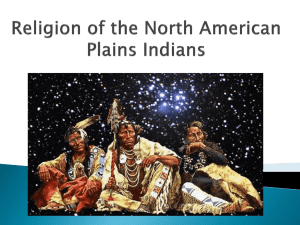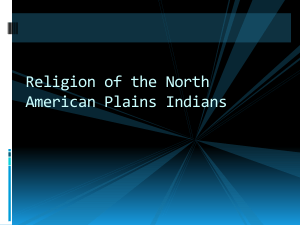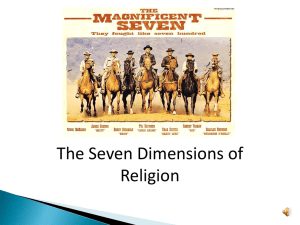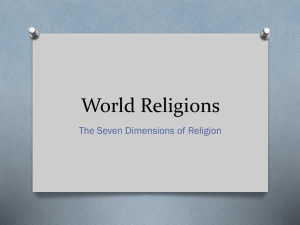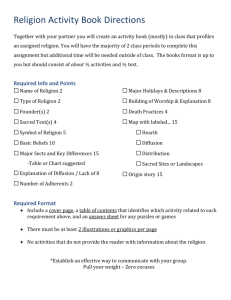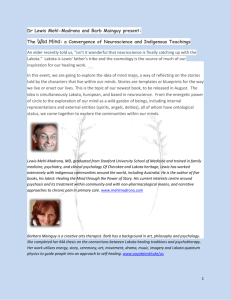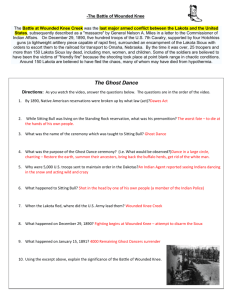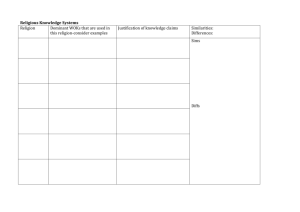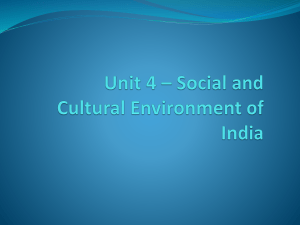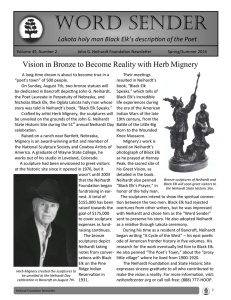Religion and American Culture: - Centenary College of Louisiana
advertisement
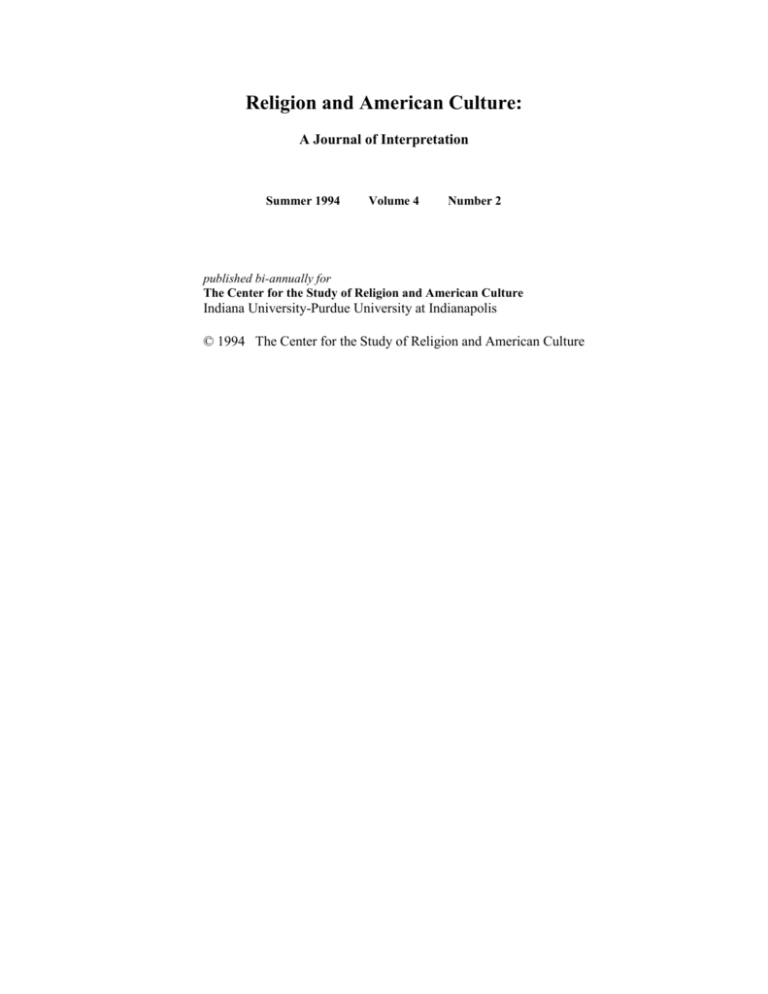
Religion and American Culture: A Journal of Interpretation Summer 1994 Volume 4 Number 2 published bi-annually for The Center for the Study of Religion and American Culture Indiana University-Purdue University at Indianapolis © 1994 The Center for the Study of Religion and American Culture EDITORS Conrad Cherry Rowland A. Sherrill Jan Shipps Indiana University-Purdue University at Indianapolis MANAGING EDITOR Thomas J. Davis Indiana University-Purdue University at Indianapolis BOARD OF EDITORS Catherine L. Albanese, University of California, Santa Barbara Dorothy C. Bass, Chicago Theological Seminary William Dean, Gustavus Adolphus College Jay P. Dolan, University of Notre Dame Sam D. Gill, University of Colorado E. Brooks Holifield, Emory University Mark A. Noll, Wheaton College Amanda Porterfield, Syracuse University Jonathan D. Sarna, Brandeis University David L. Smith, Central Michigan University Winton U. Solberg, University of Illinois, Urbana-Champaign Stephen J. Stein, Indiana University, Bloomington Peter W. Williams, Miami University, Ohio David W. Wills, Amherst College Robert Wuthnow, Princeton University Religion and American Culture A Journal of Interpretation Summer 1994 Volume 4 Number 2 CONTENTS 135 The Easter Parade: Piety, Fashion, and Display by Leigh Eric Schmidt 165 Vernacular American Landscape: Methodists, Camp Meetings, and Social Respectability by Roger Robins 193 The Church and American Destiny: Evangelical Episcopalians and Voluntary Societies in Antebellum America by Diana Hochstedt Butler 221 Racial Justice and the People of God: The Second Vatican Council, the Civil Rights Movement, and American Catholics by John T. McGreevy 255 Song and Dance: Native American Religions and American History by Lawrence E. Sullivan 275 List of Contributors Religion and American Culture: A Journal of Interpretation Summer 1994, Vol. 4, No. 2, pp. 255-273 Song and Dance: Native American Religions and American History Lawrence E. Sullivan The Irony of Inserting Native American Religions Into American History What are some recent works on Native American religions that make good additions to courses on American History? With this question, the editors framed their charge for this review. This is a good moment to pose such a question because of the recent upsurge in publishing on the subject of Native American religious life. The treatment of some recent books is outlined in three stages that cover three ways of including Native American religions in courses: framing questions, case study, and key themes. Of course, teachers teach best within the compass of their own interests. This is where their passions reside and where there is the deepest motivation to communicate clearly with others. There is much to be interested in and passionate about in the recent publications on Native American religions. Can there be a more pressing question for historians of American culture than this: how will we reflect on and evaluate existence in time in America? Within this question are embedded others: what unites those who live in America; what divides us? What are the historical sources of identity, of common purpose, of debate? How shall we understand ourselves, and how ought we to act for the common good on the basis of that self-understanding? Almost any answer to the above questions meets a truth-test, a limit-case, in the history of Native Americans. Thus far, Native American history has been stitched clumsily onto historical narratives of post-Columbian American history; and, ironically, Native American identities are shoehorned uncomfortably, if at all, into theories that account for the nature of American culture. This lack of fit—for those who struggle with it—is prodding historians and interested citizens to recast their narrative accounts and theories. For now, there are no ready-to-wear answers to the questions of how best to tell an American tale and how best to conceptualize the process of the construction of American identities. The reflections that will lead to larger self-understandings are going on in our classrooms, among other venues. This review aims to facilitate the inclusion of Native American culture in that process of reflection. I. Frame-Issues and Course Guides Today such reflections are mapped across a landscape marked with realizations that alternately disturb and empower. Realizations about the material bases of our social identities loom large: about the land and its ecology, economic power, and sexuality. So do realizations about the ideational foundations of our identities: the idea of "Europe," "the other," "nature," "race," and so on. Recent publications on Native American religions echo these broad realizations that percolate through our cultural moment. In "Facing Facts About Native American Religions," which introduces Native American Religions: North America (New York: Macmillan, 1989), a textbook I edited for use in basic courses on Native American religions, one finds bibliographies that might be used to good 256 Religion and American Culture advantage in teaching. This review will discuss some works published in the intervening period. There is space here only for a small selection. The following books might be presented in the context of discussions that would balance, supplement, or even criticize their premises and interpretations. That is, they provide a basis for educing reflection and inquiry about the history they present and the process by which they present it. In developing course materials, one could turn to Teaching American Indian History: A Selection of Course Outlines (Chicago: Newberry Library, D'Arcy McNickle Center for the History of the American Indian, 1988). Ward Churchill and M. Annette Jaimes, "American Indian Studies: A Positive Alternative," The Bloomsbury Review 8 (September/October 1988), call attention to difficulties that ought to be avoided in teaching about Native American cultures, and they outline several thematic, interdisciplinary courses with readings. Lawrence E. Sullivan, "Teaching About Religions Native to the Americas," found in a book edited by Mark Juergensmeyer called Teaching the Introductory Course in Religious Studies: A Sourcebook (Atlanta: Scholars Press, 1990), outlines common issues that can arise in framing courses on Native American religions and some conceptual and bibliographic resources that may help to address them. Åke Hultkrantz, the Swedish historian of religions who has written influentially on Native American religions for some four decades, reviewed the best literature on the subject published in the 1980's. His chapter "A Decade of Progress: Works on North American Indian Religions in the 1980s" is a useful survey and appears in Christopher Vecsey, editor, Religion in Native North America (Moscow, Idaho: University of Idaho Press, 1990). Known for his exhaustive control of the literature, Hultkrantz deemed the number and quality of publications appearing in the last decade "astounding" and predicted that "scholarly interest will grow still stronger" (191). Vecsey's collection of readable essays is a helpful orientation to important issues that arise in teaching about Native American religions. In one, Armin W. Geertz raises questions about the nature of authorship, native informants, and final form at work in Frank Waters' Book of the Hopi. In another, Amanda Porterfield examines American Indian spirituality movements, historical as well as contemporary. She concludes, "While earlier prophets tried to revitalize Indian cultures and save them from destruction or assimilation, their successors look to the revitalization of Western culture. In certain hidden but nevertheless important ways, American Indian spirituality is like a Christian reform movement within American society" (162). Moreover, in a valuable way, Religion in Native North America examines the tension between long-standing traditions (as in Maria N. Powers' scrutiny of the figure of White Buffalo Calf Woman who brings the sacred pipe to the Lakota people), on the one side, and communities quickly adapting to changing circumstances, on the other side (as in Thomas McElwain's analysis of the language of Seneca Christian hymns). Many students are often unaware that the practice of Native American religious life has been made difficult since the time of contact; and, if they become aware of the difficulties, they are uncertain why religious life should be the center of controversy. In educating citizens to a liberal education, it is important to set the stage: the religious life of Native Americans has not unfolded in a neutral vacuum but in the face of obstacles, adversity, and misunderstanding. The struggle of Native American people to practice their religious life freely is reflected in the history of American law. U.S. federal Song and Dance 257 agencies, the courts, and the state and local governments have all been called upon to respond to native religions and their concrete expression in the form of sacred sites, natural resources that are part of ritual cycles, and local authorities. In Disputing the Dead: U.S. Law on Aboriginal Remains and Grave Goods (Columbia and London: University of Missouri Press, 1991), H. Marcus Price III, an attorney and anthropologist, reviews in technical detail the state and federal laws concerning ownership and restoration of the more than six hundred thousand sacred symbols and objects currently in the possession of museums, universities, private collectors, and historical societies in every state of the union. Beginning with the Antiquities Act in 1906, federal laws were designed to preserve aboriginal sites and remains. To date, these efforts have culminated, in 1989, with the National Museum of the American Indian Act and, in 1990, with the enactment of the American Graves Protection and Repatriation Act. These more recent pieces of legislation shift from an older view focused on remains as primarily a form of property to a view of them as cultural heritages to be preserved and repatriated or even reburied. These disputes promise to keep Native American cultural constructions in the news because of the debates inside and outside of the native communities. "Competing values held by the majority population include the integrity of private property, the advancement of science and education, the stand against taking property without compensation, and possibly the principle of maintaining separation of church and state. An even more significant obstacle might be concern over the cost of the preservation programs" (119). Knowledge of these disputes over remains may provide an especially reflective moment for students because it is in relation to the holdings of museums and the ethnographic pictures they paint for the public that the engines of academic research universities and centers of study become most directly involved as institutions and policy-shaping entities affecting Native American life. The collected physical remains have generated a stance toward Native American life that has depicted them as static cultures of the past, fossilized images of the "Vanishing Indian." The repatriation of remains from sacred sites and graves is an area of open dispute and vast complexity and so is instructive about the formation of community values, the creation of tradition and ethnic identity, as well as the transformation of contemporary Native American social dynamics and related processes of dispute resolution. The trail of conflict discerned in the history of law, however, goes far beyond current legal disputes over disturbed burials. "There is a long history," writes Christopher Vecsey in the Handbook of American Indian Religious Freedom (New York: Crossroad, 1993), "of intolerance, hostility, and persecution regarding Indian religions, a history that is not entirely over" (15). Law and Human Rights The Handbook of American Indian Religious Freedom, which Vecsey edited, is an eye-opener and could find a place in many course settings, since it reviews the basic structures, language, and decisions that ensure fundamental constitutional freedoms in America. "One can point to a long history of New World jurisprudence—including the foundational concepts of United States land title—in which Indian nations have been denied their sovereignty and rights to territory on the basis of their religions" (ibid.). The volume evaluates key developments in regard to religious freedom since the 1978 passage of the American Indian Religious Freedom Act by the Ninety-fifth Congress and reviews the history that led to its passage. The act itself is presented and analyzed. So too 258 Religion and American Culture is the relationship of that act to court decisions and legislation affecting holy sites (e.g., burial grounds, shrines, or ceremonial spaces); repatriation of human remains and sacred objects; the use of sacred plants (e.g., peyote); and the limits of rights and privileges. This last issue is particularly decisive. Are Native American religious freedoms universalistically based, with a history antedating the advent of Europeans and their laws; or are those freedoms particularistic privileges granted to tribes as corporate-like entities under the law? Native American cases become particular instances of a contemporary worldwide debate over the nature and source of human rights, their relation to the dignity of the human person, and to the rights of states to sovereignty. Different approaches to law itself are presented and evaluated in the Handbook. Is law primarily a bulwark that defends individual interests; or is it a medium, a facilitating field of communication, where solidarity and common cause are sought and found? How do differing philosophies of law affect religious freedoms in native communities? Such questions are examined by specialists in legal studies, anthropology, religious studies, and government. Each essay contains recommended strategies for better protecting the exercise of religious freedoms of Native Americans. Vernon Masayesva, vice-chairman of the Hopi Indian Tribe, presents a final statement with which all contributors concur: "The American Indian Religious Freedom Act has been called the law with no teeth. Sadly, this is true.... A new beginning is needed" (136). Masayesva makes several suggestions based on the awareness that many of the Europeans who came to this land did so to escape religious persecution. He urges that, in the same spirit, greater protections be afforded Indian religious rights and greater care be taken in considering the distinctive contours and expressions of native religions. II. Case Study One way to insert Native American religions into courses on American history is to develop a case study that focuses on a single tribal community or a set of communities that are linguistically and culturally related. The case study offers the advantage of setting religious ideas in the context of a thick description of culture, tracing changes over time and evaluating contending interpretations of the same phenomena. The literature on many native communities lends itself to case study. Reference to some recent publications about the Sioux (Lakota, Oglala, Dakota) illustrates how a case study allows for many instructive angles of vision. In 1992, the University of Nebraska Press once again published an edition of the well-known Black Elk Speaks: Being the Life Story of a Holy Man of the Oglala Sioux, first published in 1932 by John G. Neihardt (Flaming Rainbow) (Lincoln and London: University of Nebraska Press, 1992). In his introduction, Vine Deloria, Jr., a lawyer, philosopher, and member of the Standing Rock Sioux community, extols the book: "[John] Neihardt's Black Elk Speaks and When the Tree Flowered, and The Sacred Pipe by Joseph Epes Brown, the basic works of the Black Elk theological tradition, now bid fair to become the canon or at least the central core of a North American theological canon that will someday challenge the Eastern and Western traditions as a way of looking at the world" (xiii-xiv). This is not the way William K. Powers sees it. Powers believes that Black Elk Speaks exemplifies the reality that "much of what passes for Lakota religion today is the product of the white man's imagination" ("When Black Elk Speaks," in Vecsey, Religion in Native North America, 136). Powers underlines Black Elk's Song and Dance 259 Catholicism and what Powers describes as an evident lack of interest in Black Elk's philosophy among influential elders in the Lakota community today. Regarding the controversies surrounding the interpretation of Black Elk's ideas, especially whether or not they represent more the poetics of Neihardt than the thoughts of the Oglala holy man, Deloria is emphatic. "Can it matter?" he asks. "The very nature of great religious teachings is that they encompass everyone who understands them and personalities become indistinguishable from the transcendent truth that is expressed. So let it be with Black Elk Speaks" (xiv). In fact, the interpretations, criticisms, and counter-interpretations that swirl around Black Elk Speaks can be instructive in a course on Native American religions. The diverse opinions bring home to students the complex forces that must be negotiated in constructing identities in Native communities today as well as in constructing interpretations of their religious lives. Instruction built around the thoughts of Black Elk ought to consider recent works edited by Raymond J. DeMallie. In The Sixth Grandfather: Black Elk's Teachings Given to John G. Neihardt (Lincoln and London: University of Nebraska Press, 1984), DeMallie presents the entire body of shorthand notes, fully transcribed and annotated, of the interviews Neihardt conducted with Black Elk. Vine Deloria, Sr., a retired Episcopal missionary and father of Vine Deloria, Jr., worked with DeMallie on the translation of Black Elk's letters written in Lakota. In the great vision that he unfolded in the narrative of Black Elk Speaks, the Lakota holy man saw himself as the "sixth grandfather," the spirit of the earth who possessed the power to heal and nurture growth. DeMallie thinks the title suits the book because Black Elk's teachings "have had a marvelous generative power: they have grown and blossomed and become an inspiration for millions, Indians and non-Indians alike" (xxii). The Sixth Grandfather gives one a feeling for the complicated web of interpretations that surround knowledge of Native American religious life. Neihardt met with Black Elk in 1931 and again in 1944. Communication was transacted as a family affair. Black Elk expounded his views in Lakota; his son Ben then uttered a rough translation in idiomatic English. Neihardt would rephrase the sentence in standard English. Next, Ben would repeat the rephrased sentence to Black Elk in Lakota for further clarification. Turning to Neihardt, Ben would affirm or adjust the statement in English. Neihardt's daughters then took dictation of the final revised form that their father repeated in an English rendering. "What was written down was not, strictly speaking, a verbatim record of Black Elk's words, but a rephrasing in comprehensible English. While this could sometimes be one or two steps removed from the old man's actual words, in the long run it was likely to generate fewer misunderstandings and to be more faithful to the intended meaning than a strictly verbatim recording. In a sense, Neihardt was already 'writing' Black Elk's story ..." (32). As all the parties to the communication practiced their roles, the rhythm moved from a lurching one to a steady flow in which all knew their part. Neihardt's daughters Enid and Hilda took down the dictation in stenographic shorthand and, later, directly onto the typewriter. Subsequently, Neihardt developed transcriptions that, in turn, served as a basis for his creative transformations of Black Elk's thought into stirring literary works. In The Sixth Grandfather, the tensions inherent in the process of translation and interpretation, and the vulnerability of meaning in the circumstances of field visits 260 Religion and American Culture fraught with potential misrecognitions, are laid bare for discussion and evaluation. The empathy between the two principals, their apparent unity of purpose, is threatened by the gulf between their distinct cultural backgrounds and their different media of expression. It is rare to see the messy inner workings of the process of cross-cultural understanding disclosed in this way. DeMallie provides context that compounds the story even further. He details the biography of Black Elk, from his three-year tour in Europe, beginning in 1886 as part of Buffalo Bill's Wild West Show, and his career as a prominent medicine man in the late nineteenth century, to his conversion to Roman Catholicism in 1904 and his long-term dedication as a missionary-catechist, to his encounters with Neihardt. In the end, the abiding desire of Neihardt and Black Elk to communicate to one another their extraordinary experiences and their desire to communicate to others the beauty and power of their understandings overcame the obstacles inherent in the very process of that communication. William K. Powers questions whether the understandings of Neihardt and Nicholas Black Elk can illumine Lakota religious life. He even calls Black Elk Speaks one of the "fabrications of the white man" and a form of "literary imperialism" ("When Black Elk Speaks," 149). Though Black Elk Speaks now exists in English, German, French, Italian, Russian, Hungarian, Spanish, and Portuguese, Powers points out that no Lakota version has been published. He asks, "Is it not immoral to witness the creation of an Indian religion by a romantic white man? The religious zeal of even more romanticists is overshadowed by their total ignorance of a Lakota religion learned first hand from those ritual specialists who are not the subjects of books and who are, therefore, more nearly akin to the ideal type of Lakota medicine man accepted by Lakota culture" (ibid.). Powers presents Lakota religious practice, as he has learned it from community members, in his Oglala Religion (Lincoln: University of Nebraska Press, 1977) and Yuwipi: Vision and Experience in Oglala Ritual (Lincoln: University of Nebraska Press, 1982). Yuwipi describes in detail the ritual of the same name and the associated vision quest. Powers has also gathered knowledge about a wide range of Lakota religious belief and practice in his Sacred Language: The Nature of Supernatural Discourse in Lakota (Norman: University of Oklahoma Press, 1986). Based on the insights and methods of ethnolinguists like Dell Hymes, Powers postulates the existence of two significant "speech communities" among Lakota-speaking medicine men. The first is the group of fellow medicine men who communicate to one another their ideas about the afterlife, the creation of the world, the nature of life, and so on. This first sacred language is the language of philosophical discussion. In the second significant speech community, medicine men communicate with their supernatural guides and power-helpers: powerful birds, animals, inanimate objects, and the human dead—all of whom possess special knowledge about sickness, health, life, and death. Each speech community generates its own type of sacred language (a term and book title Powers translates from the Lakota wakaniye—wakan means "sacred" and iye means "to speak"). "Sacred language is created out of performance, sometimes public and sometimes private, and is always perceived to be mysterious, unfathomable, indecipherable, and unintelligible to the common people" (5). The medicine men that Powers describes have experienced a special vocational calling during recurrent crises that affect them in their adolescence. The symptoms of the crises (sickness, depression, melancholy) are, in fact, signs of their election by powerful Song and Dance 261 supernaturals from the West who instruct them in the rites and language that effect their own cure. The renewal of sacred language in each generation accounts for its contemporaneity. Although the language is exclusive and includes archaisms, it is not archaic but highly adaptive to change. Powers examines the relationship of this language—its constancy and its fluidity—to the larger Oglala tradition. Powers provides fascinating analyses, both numerological and musicological, of Oglala categories of nature and culture. Through an investigation of the systems of correspondences (of colors, directions, calendrics, prime elements) built on the separate but interrelated base numbers of four and seven, Powers outlines the rudiments of Lakota cosmology. "The numerical system clearly takes precedence over the objects which it seeks to classify" (143). The use of the two numerical systems used in sacred languages suggests the degree of systematic reflection that undergirds Lakota worldviews. In the case of song and music, Powers argues that they are spoken of as part of the natural world. This is because, like blood, sweat, tears, and speech, song emanates from the body and is considered a physiological function. Powers' consideration of songs associated with ceremonies and vision quests is particularly moving and instructive. Under the medicine man's instruction, the questor trains, observes a vigil, and awaits a vision, which will include a song. The songs learned in visions are gifts of the spirits who equip humans with songs so that humans might communicate with them. Each year, usually in the spring, medicine men carry out their winter vows to seek further visions in the seclusion of the hills. There they obtain new songs that can help effect cures and address other needs. The repertoire of powerful songs is expanded and renewed each year. In the songs, the spirits empower the medicine men to deal with real, ongoing problems of poverty, family health, job opportunities, and neighborliness. Powers' delineation of the two kinds of sacred language enables him to evaluate the impact of Christian missionization and of anthropology on Lakota culture. Lakota culture has attuned itself to the interpretations of missionaries and anthropologists (such as the observations of the physician-ethnographer James R. Walker). In constructing a case study of Sioux religion, one would want to consider another work edited by Raymond J. DeMallie together with Douglas R. Parks, Sioux Indian Religion: Tradition and Innovation (Norman: University of Oklahoma Press, 1987). The volume is the outcome of a 1982 gathering in Bismarck, North Dakota. At that assembly, the Sacred Pipe bundle was set away for seven years, following the instruction of the spirits. DeMallie and Parks gather together the reflections of various community members on the blessings brought by the pipe. What is fascinating to read is the range of religious opinion represented within the contemporary community. Vine Deloria, Sr., living as an Episcopal priest in Pierre, South Dakota, portrays the history of his family and describes, in particular, the religious beliefs of his grandfather, Francis des Lauriers, who was a convert to Christianity. (Harvey Markowitz and Robert Hilbert, S.J., write on the role of Catholicism in the Sioux communities.) Emerson Spider is interviewed in his capacity as Oglala bishop of the Native American (or Peyote) Church. Beatrice Medicine, a professional anthropologist, reflects on the place of women in the revitalized ceremonial life of the community. She emphasizes the balance that ought to obtain between the sexes so that ceremonial life be creative. Mercy Poor Man speaks as a Christian fundamentalist and preacher in the Christian Fellowship Church. Stirring testimony of quite a different sort is put forward by Arval Looking Horse, who is the 262 Religion and American Culture nineteenth generation of keepers of the pipe. In their own terms, these community members can lead readers to the realization that there are many differentiated understandings of the community's religious heritage. This is precisely the point made by Arthur Amiotte: "Lakota culture has never been static; it never has been monolithic. It always has been undergoing a process of change. In fact, the process of life itself is one of transformation" (89). Amiotte develops this point not only in his essay but also in the striking and thought-provoking illustrations that appear throughout the volume. Remarkably, this range of individual views was noted in materials written earlier but only recently made available. James R. Walker lived in the homeland of the Oglala Sioux for eighteen years, practicing as a physician on the Pine Ridge Reservation in South Dakota from 1896 until 1914. With the help of Oglala instructors and collaborators, Walker was schooled as a Lakota holy man. The elders of his day believed, after consultation with the divine powers, that Walker should first learn about the traditional religion. Religion would form the foundation of his knowledge about other aspects of Lakota life. He published his syntheses of this instruction in 1917 in The Sun Dance and Other Ceremonies of the Oglala Division of the Teton Dakota. Now a new series of volumes has been published to present Walker's notes in full. This is important and exciting because they contain the statements of the individuals from whom Walker obtained his knowledge. Most notable, from the point of view of religious studies, are Walker's Lakota Belief and Ritual, edited by Raymond J. DeMallie and Elaine A. Jahner (Lincoln and London: University of Nebraska Press, 1991), and his Lakota Myth, edited by Elaine A. Jahner (Lincoln and London: University of Nebraska Press, 1983). One is furnished with an ample biography of Walker as well as descriptions of the context of the community and individuals who decided to pass on to readers, through Walker, their rich legacy of religious thought. From these volumes, we can better understand how these influential members of the tribe understood religious beliefs and expressions. Since a variety of views is expressed, it is also possible to have a better glimpse of how outlooks were adjusted in the face of changing circumstances. In the 1991 edition of Lakota Belief and Ritual, DeMallie offers two sections, valuable for teachers and researchers alike, in which he selects and evaluates comparative materials for the study of Sioux religion. He reviews materials that are historical as well as the most recent works on the subject and provides the best orientation to existing literature in the field. III. Key Themes: Change and Contact Aside from case studies of specific communities, a course might be built around key themes that can be investigated through recent literature on Native American religions. Cultural change has become one such important subject of study, appearing as an antidote to the notion that traditions remain fixed and that people who respect traditional ways remain relatively unaffected by or thoughtless about their shifting circumstances. A number of recent studies explore cultural change, whether that change be provoked by the internal dynamics of a social system, external contacts, or thoughtful individuals facing new circumstances. Internal Processes of Change A growing body of literature views the ritual complexes internal to society as systems that change. Change is intrinsic to a vital society, and the public performance of Song and Dance 263 ritual serves as the principal instrument of such ongoing change. This view countermands a conception, widely held since the Protestant Reformation, that ritual systems are, by their nature, conservative of the status quo. In Deliberate Acts: Changing Hopi Culture Through the Oraibi Split (Tucson: University of Arizona Press, 1988), Peter M. Whiteley argues that "many Hopis continually subject their society to critical analysis, with depths of cultural insight far more penetrating than most anthropological accounts reveal" (287). Whiteley sets out to explain the transformations that occurred on Third Mesa beginning in 1906. Oraibi, which had long been the largest Hopi village and a center of resistance to colonialism from the earliest times of contact, was the only village to speak of on Third Mesa. In 1906, a "traditional" group left Oraibi to found the new settlement of Hotevilla. Some of them came back to Oraibi only to found another new settlement later on at Bacavi. This was no casual hiving off of one group from another. "Simply, the split shattered the axis upon which the Oraibi world pivoted" (244). Instead of basing his analysis primarily on kinship or economic order, Whiteley takes his cue from those Hopi who treat the ritual order as the foundation for social reality. At the turn of the century, Oraibi was governed by a complex religious structure orchestrated by initiatory religious societies. Ritual knowledge and ritual authority accounted for the political differentiation into an elite and commoner class far more than did economic differences. Reversing the usual order of things by basing his analysis on ritual order, Whiteley does account for economic and political life in fine detail. But more than that, such a reversal enables Whiteley to drive toward a rather startling conclusion: that the religious leadership of Oraibi deliberately intended to destroy the ritual order on which social behavior was grounded. The intentional destruction of the ritual center of life effected, as a consequence, radical social change. In short, the religious leadership brought about a social revolution through manipulation of the ritual core of life. The nineteenth-century Tlingit community, occupying some five hundred miles along the Northwest Coast, was constituted by the performances of a central ceremonial complex, the mortuary potlatch. This is the argument of Sergei Kan in his award-winning Symbolic Immortality: The Tlingit Potlatch of the Nineteenth Century (Washington and London: The Smithsonian Institution Press, 1989). The Tlingit first came into contact with Russians in 1741 and thereafter became heavily involved in maritime fur trade for arms, tools, tobacco, beads, glass, blankets, clothing, and luxury items. Kan examines the systematized rituals of exchange that existed in the period before American colonization of the area. Kan's approach to continuity and change, based on Tlingit ethnopsychological notions of construction of the person through ritual, is fascinating. Kan examines emotions as stylized, prescribed, and culturally constituted systems. He acknowledges that emotional life arises from human biology but recognizes also that emotional life is orchestrated and expressed in descriptions and concepts that are public and susceptible to cultural analysis. The Tlingit held a theory of emotions that explained also the need for the aesthetic performances of the pot-latch. Since this ceremonial complex best accounts for both the continuity of Tlingit tradition through time as well as its adaptation to change, it is the best place to come to grips with the Tlingit self-understanding of their agency in history. The dead and death-related beliefs and emotions are central to Tlingit culture. The 264 Religion and American Culture memorial potlatch is an articulation of these beliefs and sentiments enacted through elaborate systems of exchange. These enactments generate social ties and critical understandings. Kan is careful to argue that the potlatch cannot be reduced to a ceremonial "mask hiding the brute facts of power, inequality, and competition. [It is] much more than a form of 'false consciousness'—an ideology legitimizing the aristocracy's dominance over the rest of the population" (292). Instead, particular notions of the sacred placed limits on maximization of power and on hierarchical tendencies and promoted generosity, self-sacrifice. and cooperation. The worldview of the Tlingit could endure and change because it was predicated on "ultimate sacred postulates, beliefs about the dead [that were] sacred, enduring, invariant, and authoritative" (293). That is, Kan wants to argue and demonstrate that Tlingit society is an outcome of religious motivations aiming to compose and recompose the elements of the human person through ritual and then redistribute these elements properly through society and the cosmos after death in order to optimize health, wealth, and abundance. The transformation of death into a life-affirming event, generative of social existence and material sustenance, required the transformation of the mourners' emotional state through ritual. Kan not only studies the nineteenth century Tlingit potlatch in historical context, but he also places the ritual complex in comparative perspective as well by looking at other Northwest Coast communities and, in suggestive allusions, at Indonesia, Melanesia, and Madagascar. Indeed, he hopes that his culture-specific study will lead to additional comparative studies. Robert A. Brightman discovers the internal drive toward change among the Rock Cree, foragers of Northern Manitoba, in their magico-religious relations with animals and their habitats. This draws attention to the centrality of the ecological and dietary bases of the population. In Grateful Prey: Rock Cree Human-Animal Relationships (Berkeley: University of California Press, 1993), Brightman argues against the notion that biological needs and ecosystemic efficiency dictate the logic of the changing Rock Cree designs of culture. While emphasizing the importance of the magico-religious worldview, Brightman also rejects the notion of a religiously motivated "aboriginal land ethic" or of a religiously significant environmental management (or "environmental ethic") of the sort found in Calvin Martin, Keepers of the Game (Los Angeles: University of California Press, 1978), and Christopher Vecsey, American Indian Environments (Syracuse, N.Y.: Syracuse University Press, 1980). Brightman considers Vecsey wrong on two counts: "First, the 'environmental ethic' and sustained yield management practices were not elements of Algonquian culture in the first place. . . . 'Environmentalism' is a creation of the white popular imagination and its academic redactions. Second, the Algonquians are excused for practices that Vecsey calls 'overkill' or 'waste' of resources but that originally possessed no such meanings for the Algonquians" (Grateful Prey, 283). What drives forward change among the Rock Cree? It is the very fact that no smooth order of symmetries and perfect reciprocities exists in the Rock Cree cosmos. Rather, human and animal relations reveal a world of differential currencies for each species. These imparities come to light in dreams, myths, songs, and ritual action. Reciprocity is stressed, yet, in the vocabulary of sacrifice and meat-sharing, where reciprocity is the leitmotiv, hunter-prey relations are shown to be exploitative, unequal, and even cannibalistic or terrifying. Change in the Rock Cree world is propelled by these disparities and is nowhere so much in evidence as in the cycles of feast and fast. There is Song and Dance 265 a tolerant resignation to transient hardship (the expected and meaningful ritual use of intermittent periods of hunger), coupled with the optimism that meat "wasted" by nonstorage will be recouped by fresh kills in the near future. It is precisely because of the denial of reciprocities that such resignation and optimism can couple with one another in the magico-religious program. Change is impelled by the impossibility of achieving symmetry in exchange. Brightman argues that "Successful production presupposes an existing shortage that humans must create by eliminating surpluses and maintaining a condition of scarcity" (368). In such conditions, stored food would disinvite the generosity and usurp the authority of those powerful entities who unilaterally provide food for human beings. "To store food may therefore be to question the willingness of others to give. . . . Animals will not give themselves to hunters who do not need them" (ibid.). Feasting and devouring without storing surplus was the proper magico-religious stance in a cultural universe skeptical of the adequacy of human agency. Reciprocity is both collaborative and adversarial, society having constantly to shift, in both ritual action and economic activity, from the one mode of relationship to the other in ceaseless reconfigurations of relations with sources of power. Prophets and Resistance to Outside Forces Whatever might be the internal engines of societal change, it is clear that contact with outsiders has brought about drastic change in Native American populations. These externally prompted changes have also become the subject of a wave of recent studies that focus on resistance, revitalization, restoration, and revolt. Examining the settlement of the Americas through the responses of native peoples is an important species of reflection, an essential and unavoidable part of the construction of an authentic American history. In this process of reflection, native prophets and leaders of resistance played a prominent role, for they provided the galvanizing images, words, and social movements that enabled communities, native and non-native alike, to evaluate critically their existence in time. Shelley Anne Osterreich, The American Indian Ghost Dance, 1870 and 1890: An Annotated Bibliography (New York and London: Greenwood Press, 1991), provides a complete bibliography of the incredible movements associated with such prophets as Wovoka (Jack Wilson), the Paiute from Nevada who was taught a special dance and special songs by the Great Father in a heavenly vision. The message went forth into some sixteen states. It was in an attempt to join over 3,000 soul mates at the Ghost Dance that 146 members of the small band of Miniconjous Sioux were slain by U.S. cavalry in the subzero cold of New Year's Day in 1891 at Wounded Knee. Osterreich's work is invaluable to all who would wish to trace the prehistory and cultural repercussions of this paradigmatic event. The role of the prophet in leading native resistance is nowhere made more evident than in Joel W. Martin, Sacred Revolt: the Muskogees' Struggle for a New World (Boston: Beacon Press, 1991). In Martin's telling, the Muskogee prophet rebellion of 1812-14 was a religious drama that powerfully displayed the Muskogees' deepest concerns at a critical fissure in their history. "To meet extraordinary economic, political, and cultural crises, they responded with bold and extraordinary spiritual creativity" (133). The Redstick millenarian movement was a sacred revolt modeled on traditional rites of passage and world renewal ceremonies, "an initiation ceremony performed on a grand collective scale" (133). 266 Religion and American Culture Martin describes the series of earthquakes that occurred in 1811 and 1812. The resounding earth brought home to the Muskogees, among others, the fragility of the created world. Prophetic leaders explained that the shaking earth made clear that the cosmos itself opposed the colonial invasion and despiritualization of the Muskogee. "If the earth shook, it was because the Maker of Breath [Essaugetuh Emissee, who extends in the Upper World above all those things he has created below] could no longer stand the evils that Anglo-Americans forced on creation and on the people. . . . [T]he Maker of Breath inspired revolution, transforming the critical shamans into prophets of rebellion against the town chiefs and U.S. officials" (127-28). Martin also surveys the quakes in the surrounding social landscape in the preceding decade, provoked by the uprising of shamanic prophets all around the Muskogee. The details of the revolt can best be viewed as part of an initiatory pattern, a desire to provoke the beginning of a new condition of existence. This is the best light to understand the rigorous renunciation of things received from the Americans and from those friendly to the ways of white people: silver, brass, glass, beads, hoes, axes, trade goods. Initiation and renewal are also the best context to understand the slaughter of domesticated livestock, left to rot, and the abandonment of the crops of settled agriculture. In a ritual seclusion aimed at transformation, the Redsticks withdrew to the woods and withdrew from farming to the economy of hunting and gathering. Dance played an essential role in the Muskogee millenarian movement. Men and women dramatically expressed and transformed their social, natural, and spiritual relations by incorporating dance into their daily lives. In this case, it was not a dance from their own rich repertoire but one coming from outside contacts, this time from the remote interior of North America. The dance was taught to them by Shawnee prophets. Dancing was deemed the most efficacious way to socialize prophetic visions. To mark their new identity, Muskogee rebel-prophets danced a radically new dance that they imported in the fall of 1811 because of its association with Tecumseh and the Shawnee prophetic delegation. Martin reexamines the entire rebellion, including its military strategies and maneuvers, in the light of its religious blueprint. In less than one year, eighteen hundred Redstick warriors and several hundred women and children were killed in clashes with Anglo-American forces. The final treaty was negotiated by General Andrew Jackson. In all, the United States took from the Muskogees some fourteen million acres of land that was quickly settled by squatters, many of them veterans of the campaign against the Redsticks. Martin contends that the Muskogee revolt, and others like it, are the cauldrons where preexisting worldviews clash and fuse and where views of a New World emerge for parties on all sides of the confrontation. New ways of thinking and acting in the postcolonial times were initiated—new ideas about land, law, and identity. "Learning how to think and live in this new world along with its various inhabitants constituted (and continues to constitute) a great religious project for every people in this world, [a project that] found one of its earliest and most original expressions in Native American prophetic movement" (185). Using Martin as a framework, an entire course or course segment could be dedicated to the prophetic movements that propelled and navigated communities through the straits of change. Gregory Evans Dowd, A Spirited Resistance: The North American Song and Dance 267 Indian Struggle for Unity, 1745-1815 (Baltimore and London: The Johns Hopkins University Press, 1992), traces the history of two guiding ideas in many prophetic movements: the notion that degeneration in the quality of social and cosmic life was due to loss of supernatural power being drained off by invading whites; and the notion that various native groups should identify with one another and find common cause. "These twin notions did not come blindly out of the cloudless sky or rear suddenly in the moonlight. . . . They grew out of centuries of thought, and decades of experience" (22). Dowd reconstructs the history of these two identifications (native communities with one another and whites with evil) through an analysis that steadfastly keeps religious motivations to the fore. The deteriorating value of elementary sources of power are examined in the light of their ritual and mythic contexts: men and weapons; women, blood, and crops; the rituals of warfare. Dowd begins his account with the Seven Years' War, which swallowed into its field of gravity the native communities from the St. Lawrence River to the Mississippi Delta. Under the auspices of French diplomacy, the meetings that took place among native groups in the 1750's in the context of this conflict set up long-lasting networks of communication. Native communities strengthened their ties and exchanged ideas about identity and power. Symbolic strategies were traded, whether in the form of war belts, ceremonies, visions, songs, dances, or leadership patterns. Dowd refers to the period of 1745-75 as the Indians' "Great Awakening," a term that expresses the idea that, despite all the boundaries defined by politics, language, kinship, and geography, Indians did indeed share much in the way of their pasts and their present. "It was an awakening to the notion that Indians shared a conflict with Anglo-America, and that they, as Indians, could and must take hold of their destiny by regaining sacred power" (27). Along these paths of communication through common ground eventually traveled the messages of the religious prophets of resistance. Dowd develops his case through close examination of the single prophet-links in the great chain of prophet-led nativist resistance: from the earliest stirrings and florid rebellions among the Delaware, Shawnee, Cherokee, and Creek to the relentless removal policies of the Jackson and Van Buren administrations. In covering this ground, he also reviews much of the important theoretical literature on prophetic movements. Dowd closes with a rumination on the conflicts in memory, conflicts that resonate again in the arguments about the place and positioning of Native American history in the American historical constructions in our classrooms today. "Some Indians have recalled the nativists's dreams as embarrassing disasters, other have seen in them reason for pride and hope.... Though so apparently abandoned by the very sacred powers on whom they had counted for aid, though defeated, starved, murdered, and maligned, nativists did not make enemies of their progeny" (196). The memory of many prophets chronicled by Dowd is exalted and celebrated today. Change and the Investigator: Reflexive Reflections Change also occurs on the small but important scale of individual human interaction. In the ethnography and history covering Native cultures, relatively rare are the works that chronicle such transformations. One thinks of Paul Radin's brief biographies of the Winnebago personalities, Jasper and Sam Blowsnake, for example. Recently, a budding genre of subjective ethnography has arisen, sometimes styled as an ethnographic novel, as in Michael Jackson's Barawa. In these works, the author, who is 268 Religion and American Culture the ethnographer, depicts the mutual changes effected by contact between the investigator and the hosting community. The result is a cultural study that is also a hermeneutical selfreflection. Robin Ridington, Trail to Heaven: Knowledge and Narrative in a Northern Native Community (Iowa City: University of Iowa Press, 1988), is a creative and selfaware book of this experimental kind. Based on decades of involvement with the Dunneza, an Athapaskan-speaking community of northeastern British Columbia, Trail to Heaven is a moving, well-written account of revealing events in the community. At the same time, it is a solid, revealing account of movements within Ridington himself: his intellectual and existential transformation throughout a lifetime of contact with the Dunne-za (otherwise known as the Beaver Indians). His storytelling has undergone change in the company of his friends, as have his spiritual capacities and the range of realities he credits worthy of reflective attention. It is not Georg Gadamer or Paul Ricoeur who tell Ridington that much could be gained from examining his attempts to learn. The idea of a redoubling hermeneutics of his own understandings—a dogging of his own interpretive steps—was brought home to him by the Dunne-za. This hermeneutics of reflection is embedded in the book title, and it is laid out at the very close of the volume in a dizzying reflection on the capacity (and need) to be reflective. The circle of song will be completed when you see the tracks before you as your own. When you turn with the circle you will rise on the Trail to Heaven and leave them all behind you. The Trail to Heaven begins at the place where you meet your relatives. It begins when the people you knew from long ago come down to meet you. It begins when they give you a song. It begins when your own voice and the voices of your relatives become as one. (291) In ending, the Trail to Heaven thus describes how it begins. To instill even more disorienting self-reference, the book closes with a self-conscious excerpt of itself, by describing how it, in turn, was quoted at the eulogy delivered for Howard Broomfield, an audio artist and Ridington's friend and collaborator from 1978 until 1986. Continuing the theme of reflexivity, we learn that it was Howard Broomfield who helped write the piece that closes the book. Here are mirrors reflected within mirrors. All of this (and more) is quite deliberate and effective. Trail to Heaven displays, in its very form and in the functioning of its narratives, important Dunne-za assumptions about the world: that myth and dream are interior to events in the world of sensation; that knowledge is a form of power; that discourse is significant in the context of shared experience. The narrative is configured within what Ridington understands to be the structures of Dunne-za time and causality. "A moment in Indian time includes every other moment shared in the individual and collective memories of individuals, community, and culture. . . . Every event makes sense in relation to shared knowledge and experience. . . . The moments described in Trail to Heaven include and refer to all the moments I have shared with the Dunne-za over nearly thirty years" (xiv). In many ways, Trail to Heaven is the account of Ridington's post-Harvard education at the hands of his hosts. He describes his futile attempts to use standard testing techniques to generate data. Nothing is lost in his view. Through the tests, he eventually learned about his own belief in the authority of social science; about elements of his own biography; and about the personalities of his interlocutors. Song and Dance 269 Clearly, Ridington's Dunne-za education leads to more than ethnography and the output of professional anthropology. Ridington's education helped him develop an understanding of the proper relationship of humans to the world. More than that, the realities of the world are experienced in their correct relationship when Ridington is properly oriented toward death, the Trail to Heaven. "Singing and dancing are ways of clearing the path your shadow must take when you die" (95). Singing is the paradigm of speech, expression, magical power, and intellection; dance is the epitome of human action on earth. Ridington explains how the Dunne-za have prepared him for death by teaching him how to speak and act, sing and dance. Trail to Heaven consists of the efficacious signs of his progress along this path. In the book, he describes chanted stories and experiences, such as the death of game animals and of old friends, that bring home to him realizations about the nature of death and the way in which song and dance provoke progress along the Trail. The Trail to Heaven is an unusual book that probes the purpose of narrative and the power of knowledge to affect life. It may be precisely the kind of book that can educe reflections on the questions raised in the first four paragraphs of this review essay— questions about the actions and the evaluative narratives about them that constitute history. As we stand in the stream of American history, which so much shapes our identities, what is Native American religious history to us? How will the religious experiences and worldviews of Native Americans assume their proper place—in our courses, in the worldviews reflected in our universities, and in the telling of the American tale? What repercussions will touch the self-understanding of individual, community, and nation?
